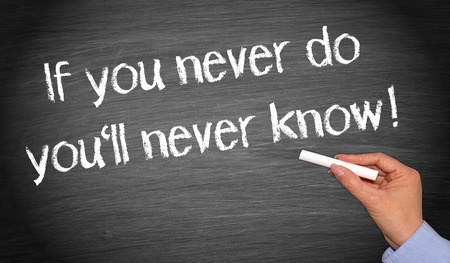Podcast: Play in new window | Download
Subscribe: RSS
EPISODE 31: The Knowing and Doing Gap
Many of us know what to do but fall short on doing what we know we need to do. The difference between knowing and doing is that in knowing-what you believe to be true and is based on the knowledge and experience you have. Whereas, doing is about the actions you take based on the knowledge and experiences you have.
The gap between knowing and doing can be small as dime or as large as the universe. We filter the world through what we believe-what we know. Our perception is our reality. It does not mean it is always correct. Have you ever made an assumption and realized that you are totally wrong?
 Doing means taking action – it means taking a risk. Why is it that so many of us know what to do but do not do it? You are operating from a place of fear. You’re scared to take risks because you scared to step out of that comfort zone. The comfort that you believe will protect and keep you from harm. It is a human need to feel safe and secure. You can take calculated risks. Calculated risks are where you have done your homework and decreased the risk, and lessened the uncertainty. And most of all minimized your fears.
Doing means taking action – it means taking a risk. Why is it that so many of us know what to do but do not do it? You are operating from a place of fear. You’re scared to take risks because you scared to step out of that comfort zone. The comfort that you believe will protect and keep you from harm. It is a human need to feel safe and secure. You can take calculated risks. Calculated risks are where you have done your homework and decreased the risk, and lessened the uncertainty. And most of all minimized your fears.
- Conduct Research– Get more information by surfing the web or reading articles or magazines or books in the area that you need more information.
- Ask Questions. Interview someone who has been where you want to be or has the knowledge that you are seeking.
- Challenge Assumptions. Challenge others assumptions because the best way is not always the way things have been done. Encourage people to look for better ways of doing things and exploring more perspectives and options.
- Learn Best by Doing. Take small actions. Learn and adjust as you go. Learn from mistakes and experiences.

Knowing is one thing. Talking the talk. Walking the talk means that you are acting based on what you know. Talking is not the same as taking action. Talking may make you make you look smart; however, acting and doing will give you the results that demonstrate you are truly smart.
The biggest gap between knowing and doing is procrastination. As you may know what to do, this means not hesitate on taking actions. The reason for this is sometimes you don’t realize the impact on your results by not taking those actions. You could be self-sabotaging yourself from getting the success you say that you want. If you’re not willing to do and take the actions necessary, it really means that you’re not really concerned about it all. Some people just believe that they’re entitled to the results they want. Taking action means that you must put in effort and the work required getting the results you desire. Some people procrastinate because they don’t believe in themselves or they don’t have a clear vision of what they’re trying to achieve. Whereas, others are in search for perfection and they hold themselves back from taking action. By wasting time you’re wasting money, resources, and the only time you’ve got. Time is not replaceable.
 It is time to do the things we know we should be doing. If you haven’t listened to the Episode 28: Committed to Lifelong Learning take a listen as soon as possible after this podcast. Start scheduling what is important to you and stay focused on your course of action. It is one thing to know what to do and how to do it and another to actually take the steps required to make it become reality. Remember nothing happens without action.
It is time to do the things we know we should be doing. If you haven’t listened to the Episode 28: Committed to Lifelong Learning take a listen as soon as possible after this podcast. Start scheduling what is important to you and stay focused on your course of action. It is one thing to know what to do and how to do it and another to actually take the steps required to make it become reality. Remember nothing happens without action.
What is the between what you know and what you know you must do?
What action steps are you ready to take?
We would love to have you subscribed to the Success Secrets newsletter on my website at www.debrakasowski.com where you’re going to get us free MP3 download 10 Surefire Strategies to Power Up Your Productivity and Performance. I would love to hear about this podcast has impacted your life. E-mail me at Debra@DebraKasowski.com. Thank you for listening to The Millionaire Woman Show where we talk about leadership, business, and human potential to help you live rich from the inside out. Subscribe to The Millionaire Woman Show. Share it with Your Friends. Give us a 5-star rating!
DEBRA KASOWSKI, BScN CEC is an award-winning best-selling author, transformational speaker, blogger, and Certified Executive Coach. She has a heart of a teacher and is certified in Appreciative Inquiry and Emotional Intelligence. Her writing has been published in a variety of print and online magazines. Debra Kasowski International helps executives, entrepreneurs, and organizations boost their productivity, performance, and profits. It all starts with people and passion. Sign up the Success Secrets Newsletter and get your free mp3 download today! www.debrakasowski.com
Time: 7:17 min
Keywords: Taking action, belief, challenge assumptions, knowing and doing gap, conduct research, step out of your comfort zone, questioning, leadership, engagement, fear of success, fear of failure, fear of rejection

